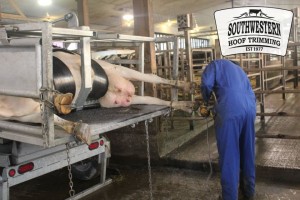 by Ladd L. Siebert, D.V.M.
by Ladd L. Siebert, D.V.M.
Hoof trimming is now a common herd health practice on U.S. dairy farms, and a cadre of professional trimmers has developed to take care of this need. These professionals generally use one of two types of equipment to restrain cows for trimming: upright trimming chutes or tilt tables. In the U.S., the tilt table has been the traditional equipment used. In Europe, it has been the upright trimming chute. Today, in the US, it is common to see both types.
The question, “Which type is least stressful for the cow?” is being asked more frequently, with opinions being expressed both ways.
At the 10th international Symposium on Lameness in Ruminants held in Lucerne, Switzerland, in September 1998, a research report was presented by Drs. Stanek, Mosti, Pachatza, and Sixt. These veterinarians are with the Clinic of Orthopedics in Ungulates and Institute of Biochemistry, University of Veterinary Medicine, Vienna, Austria The title of then· paper was, “Claw Trimming, Restraint Methods, and Stress in Dairy Cattle.” The methodology and results of this study are published in the proceedings of the Lucerne meeting.
Their research compared the plasma cortisol levels of cows trimmed in an upright trimming chute versus those trimmed on a tilt table. Plasma cortisol (a type of adrenaline) goes up when animals, or people, are stressed. For instance, if a blood sample was taken from you shortly after you had to swerve your car hard to avoid hitting a deer, the cortisol level would be elevated above normal. And, the bigger fright you had, the more stress you were under, the higher your cortisol level would be. In the Austrian study, cows on one dairy were randomly divided into two groups. One group was trimmed in an upright trimming chute and the other on a tilt table. Blood samples were drawn before, during, and after trimming.
The greatest elevation of plasma cortisol levels occurred at the end of the hoof-trimming procedure. In the raw data, there was an advantage shown for cows trimmed on the tilt table. At the end of trimming, the median plasma cortisol level of these cows was elevated less than the cows trimmed in the upright chute. However; an analysis of this data showed that the advantage for the tilt table was not large enough to be considered statistically significant.
So, what does this mean? As far as cow stress from trimming hooves is concerned, there is no practical difference between upright trimming chutes and tilt tables. When a professional hoof trimmer comes to your dairy, it is the skill and integrity of the man, not the type of equipment he uses, that determines the results.
The author is a dairy practitioner and hoof trimmer based at Eureka, S. D.
(Article originally appeared in Hoard’s Dairyman December 2002)

